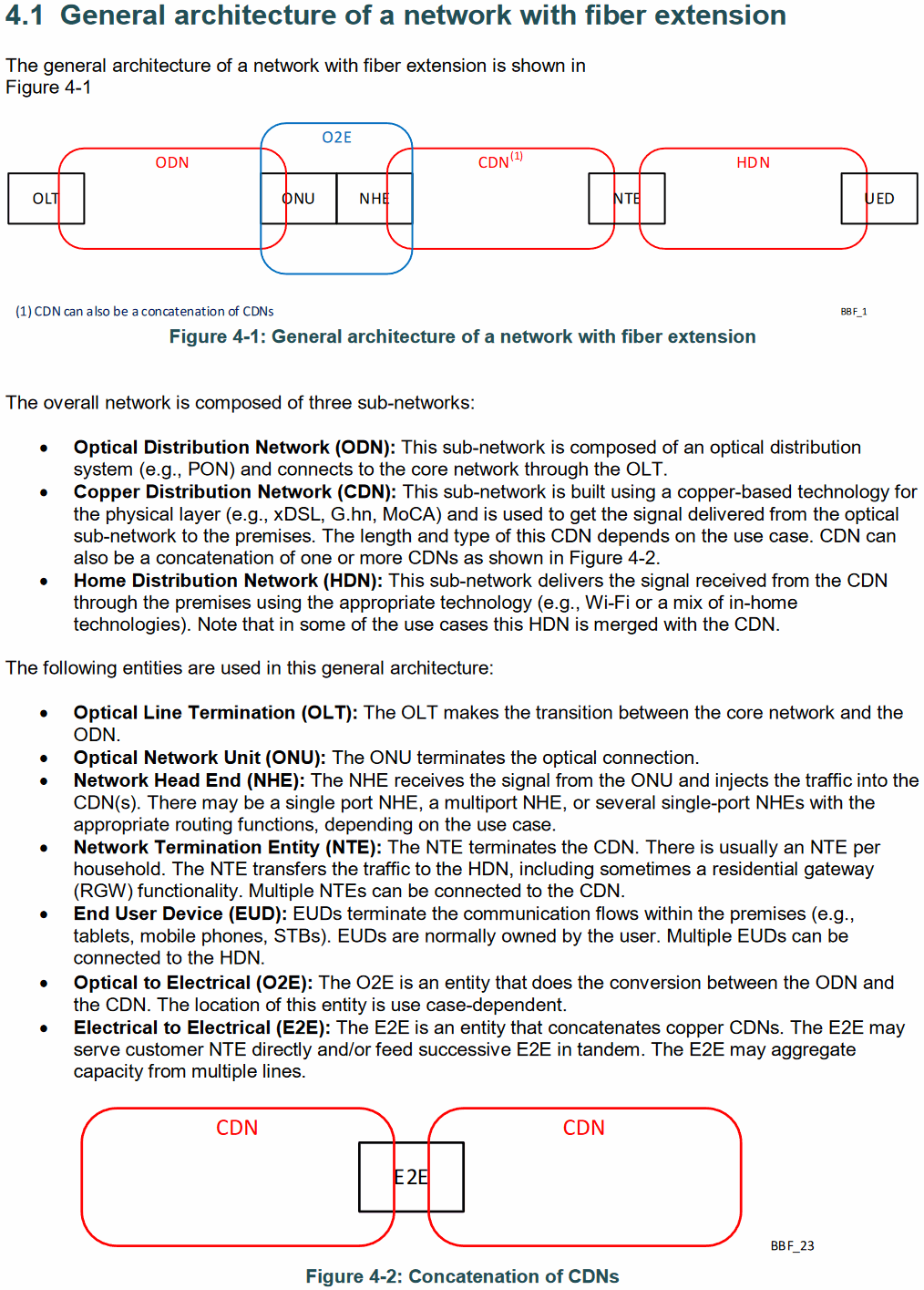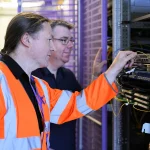Broadband Forum Propose Fibre Extension over Old Copper Lines

The Broadband Forum has published a new technical report (TR-419), which proposes a different way for “full fibre” (FTTP) builders to cut their deployment costs via a Fibre-to-the-extension-point (FTTep) approach. In short, it’s another way of cutting out the need to replace the last few metres of copper with fibre.
At this point seasoned ISPreview.co.uk readers will probably be getting a slight feeling of deja vu, since we’ve heard of some loosely similar solutions before (e.g. Fibre-to-the-remote-node [FTTRN]). But the cost and complexity of needing to deal with lots of smaller powered distribution points (or nodes) never really caught on and, in the UK, it’s probably also a bit too late to turn the clock back on the FTTP centric direction of travel.
Nevertheless, the Broadband Forum believes that FTTep might still provide an option for some operators. The main objective of FTTep, they say, is to “re-use existing copper infrastructure to extend fibre gigabit services with minimal construction work.” The FTTep can be located either outside or inside the building.
Advertisement
Meanwhile the remaining copper lines would communicate using technologies like G.fast, G.hn Access or MoCA Access™ 2.5. As only a fairly short run of copper would be present then multi-Gigabit speeds would still be attainable due to the limited signal degradation over distance.

“PON Fiber deployments in some brownfield’s areas can have a number of barriers, such as lack of ducting both in-building and outside and in-building fiber ducts, opposition to new cabling in hallways / apartments and restrictions on building access to deploy fiber. There can also be doubts over or who should pay the in-building fiber deployment costs, the – building owner or service provider,” said the report.
Herman Verbueken, Broadband Forum’s Work Area Director (Physical Layer), said:
“Fiber network technology promises multi-gigabit broadband services, and investment is only set to grow as the industry looks to enhance businesses’ and end-users’ connected experience. With higher costs associated with installing fiber directly to the premises, by adopting the FTTep architecture operators and providers will be able to deliver ubiquitous connectivity to all corners of customers’ homes and commercial premises.”
At this point it’s worth remembering that taking something like this and turning it into a solution that operators can deploy, commercially, tends to require a lot of work and trials. Put another way, if an operator in the UK were to actually pursue this (we’ve yet to see any signs of that) then it probably wouldn’t reach the rollout stage for a couple of years and by then FTTP would be much more prevalent.
Advertisement
In many ways the proposed solution feels like something that would have been more relevant had it come out a few years earlier. On the other hand there may still be situations where something like this can finds its niche.
Mark is a professional technology writer, IT consultant and computer engineer from Dorset (England), he also founded ISPreview in 1999 and enjoys analysing the latest telecoms and broadband developments. Find me on X (Twitter), Mastodon, Facebook, BlueSky, Threads.net and Linkedin.
« Court Order Forces UK ISP TalkTalk to Block Sci-Hub Website






















































Openreach tried it. Didn’t work economically.
Works in niche cases in the USA where fibre to a basement of an apartment building then G.fast or MoCA may be used.
Most of the time it’s far more economical to deliver FTTP or, if an MDU really objects, just leave them out of any deployment until they relent.
This technology is basically dead. Openreach did everything they could to make it work on the cheap and failed. If you can’t make it work on the cheap may as well just deploy fibre all the way.
Might have some life where people have no options, such as Australia’s ‘N’BN, but anything remotely competitive it’ll be overbuilt with full fibre.
When you’re having to get fibre and power to a node that serves a handful of premises the business case is usually not great. Interim solution only.
…. and it’ll be a barrier for future upgrades again. If and when 10Gbps becomes the norm (or even more), then what? Can you squeeze that through copper?
Just accept that copper is dead and move on!
When the BDUK scheme in my area didn’t manage to replace ADSL for everyone, BT had plans for a remote node in the manhole just outside my property which would have covered a dozen properties. Then they decided against remote nodes, and 7 years later we still have sub-USO level ADSL2+ (so we were at least upgraded from ADSL Max).
Personally I think a fibre to a fixed wireless node would be better, not least because it would allow connections to properties that don’t currently have copper. However, it won’t catch on…
Well, Starlink is coming. It may well be that it’ll be a reasonable alternative for people in the same predicament as you.
I don’t think Starlink is the solution in most cases – it is (understandably) expensive, and the latency, although good for satellite, is still higher than FTTP/FTTC and latency is at least as important as speed in a growing number of applications.
Personally, I am due to get FTTP via Gigaclear – they were due to complete the build in 2018, so hopefully they will actually start this year…
Starlink will be servicing up to 3 or 4 percent of population. Stop thinking about it as universal replacement of DSL.
I see nothing wrong with the proposal. Costs change, FTTP is becoming cheaper all the time and should now be the default. However where the costs of Full Fibre are prohibitive or the installation impact is high then why not. There are still many premises where USO/Voucher/BDUK is insufficient.
e.g
Historic/Listed Buildings
Preservation areas
Remote Farms and Homesteads on multiple OH spans (take FTTP as far as possible under subsidy)
FTTC changeover (ability for OR to move a whole pole over to FTTP until customer changes product)
The main issue is power. No reason why the O2E cannot be at the top of a pole solar powered and far better than WISP, 4G or nothing.
Remote farms on overhead ? ! Seriously. I live in an area where there are lots of similar properties. for example I have a run of maybe 15 poles to where my line meets 3 others, the other two heading off over shorter lengths, How you can suggest this could possibly be a viable option, to install active kit, batteries and solar charging to that pole rather than to run the passive fibre is beyond me.
Might be quicker to build but the ongoing cost of the active kit and having fibre and copper elements to maintain will be a lot higher than a pure fibre network.
Thay keep overlapping areas instead of bringing it hear we have hyper optics but so far they have been useless at rolling out
Ps this is bt King of corner cutting
Apart from the gratuitous use of acronyms how is this different from Openreach G.fast sub-node installations?
Wouldn’t having all that active kit out there bring the same maintenance issues of using line powered repeaters? A solution that’s been available for quite sometime for sub USO lines, but the technology was basically turned down.
Yes more varied kit increases costs. But those costs can change overtime and not all technology sees the light of day as the volumes aren’t there to bring unit prices down. But if solutions can be developed internationally and the volumes mean we can use it in exceptional situations then the viability changes especially if miniature, low power, externally robust devices can be developed.
We have had governments not willing to bite the bullet on universal full fibre, low USO expectation and continued acceptance that a percentage can remain excluded. If Full Fibre isn’t going to be 100% we still need alternative fixed broadband options.
Would you have your house rewired but leave some 50 year old wiring in the circuit ?
“Spoiling the ship for a ha’porth of tar” springs to mind. Save now but spend later replacing degrading copper jointing.
Wasn’t this like the original OR G.fast plan? Taking full fibre up to a node and then people using G.fast from the node to their houses?
To what node? G.fast have very short range, even worse then DSL.
Isn’t this proposal just “Fibre to the DP” again, but with a few more acronyms thrown in for good measure?
BT need to move over to full fibre,other competitors will take them on and provide full fibre.
OFCOM need get rid of slogans/naming of broadband products ie super fast and only you get 10Mbps.
BT networks need to move with the times!
This is nothing to do with BT. It’s not a BT initiative.
Quite right.
They missed the boat over 20 years ago, thanks to government interference.
Now they are happy to take the money, then do nothing for ages.
Don’t they understand radio frequencies are not efficient down copper wires (clue is in the name, wireless)
They need to be made a nationalised entity, stop trying to out do Sky, get off their derrière’s and get fibre done.
How long to the next election?
At a basic level, isn’t this roughly what Virgin do in their FTTP areas – fibre to the outside wall, then copper through the wall to the router which powers the converter?
If this is the case, is it worth it? I mean, you’ve gone to the effort of getting a fibre cable to a property. How many cases are there where you couldn’t pull through a hole in a wall to terminate the fibre internally (apart from costs of doing so).
Otherwise, it’s FTTDP again, right? (Works well in a couple of rural spots around here).
Yes essentially Virgin do this indeed and it seems crazy to do it. Basically they are carrying RF over glass (RFoG) so it is fibre in a sort of legacy CATV mode and cheaper to deploy as other parts of the network don’t need upgrading. Virgin Media Fibre = a poor mans FTTP.
It makes total sense for Virgin to do it this way, as it maintains compatibility with the rest of the network and enables them to use the same consumer equipment. The other added advantage is significantly less noise and cross talk. DOCSIS has a lot of life left in it and most of the limitations of Virgin’s service (such as slower upload) are not limitations of DOCSIS; they’re either self imposed or Virgin doesn’t yet have the switching capacity/backbone throughput to go higher. IF Virgin decide to change technologies in the future, their existing fibre deployment allows them to do so with reduced impact to their fixed infrastructure.
This proposal sounds good and would have been ideal for us as there is FTTC all round the village but many places including the local grocery store use Sky or 4G. Our router supplied by Openreach – which was connected to a prehistoric Cat3 cable – couldn’t achieve more than 6Mbps if that. I guess the main issue is fitting optic fibre and not exceeding pulling tension or bend radius where old copper sits.
No, just no! Don’t do it.
UK are finally getting real full fibre and that is what the UK really does need.
This is highly unlikely to be any use except in urban areas where there is a high density and most of that is commercially viable FTTP anyway.
A hybrid approach needs power and is going to contain lots of active kit. As many, many people have pointed out, in the past, once you use active kits the running costs and maintenance costs shoot up as well as reliability dropping. a good part of OR business case for FTTP is the lower running/maintenance and fault finding costs of pure fibre.
This might have been a good idea 10 years ago, before GFast when OR was trialling VDSL to the DP. That ship has sailed and the current FTTP rollout is the way to go.
Could/would the nte inject power/control down the CDN to power the o2e? A bit like an enhanced power over ethernet? Does that remove some issues for niche use cases
I think it is important to note that the Gbps network will be deployed using any technology available whether coaxial, FTTP or copper wire, 5G/6G and so on for the last section isn’t really that important only the use case.
The media isn’t that important only the speed and latency.
mmWave technology can after all be used with copper wire at short range and the speed is way above the Gbps speed requirement for deployment by 2033 in the UK!